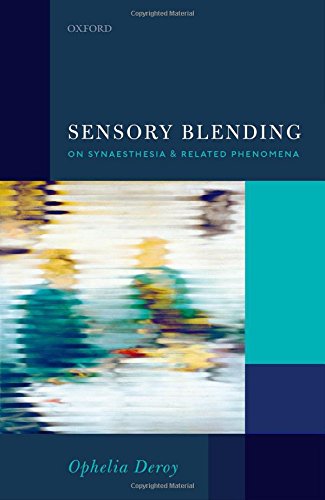(Ebook PDF) Sensory Blending On Synaesthesia and related phenomena 1st Edition by Ophelia Deroy isbn 9780191660467 0191660469 full chapters
$50.00 Original price was: $50.00.$35.00Current price is: $35.00.
(Ebook PDF) Sensory Blending On Synaesthesia and related phenomena 1st Edition by Ophelia Deroy -Ebook PDF Instant Download/Delivery:9780191660467, 0191660469
Instant download Full Chapter of Sensory Blending On Synaesthesia and related phenomena 1st Edition after payment

Product details:
ISBN 10:0191660469
ISBN 13:9780191660467
Author: Ophelia Deroy
Table of Contents:
Introduction
I.1 Beyond Minority Reports
I.2 Revising Our Definitions of Perception
I.3 Accepting Arbitrariness and Missing Control
I.4 Redrawing the Distinction Between the Senses
I.5 Overview
Acknowledgements
References
PART I: Defining and Measuring Synaesthesia
1: Synesthesia, Then and Now
1.1 Synesthesia and the ‘Unity of the Senses’
1.2 Synesthetic Perception
1.3 Synesthetic Tendencies in Perception
1.4 Synesthesia vs. Synesthetic Tendencies
1.5 Synesthetic Tendencies in Children
1.6 Synesthetic Tendencies in Language and Metaphor
1.7 The Puzzle of Synesthesia
1.8 Varieties of Synesthesia
1.9 Perceptual-Perceptual Synesthesia
1.10 Cognitive-Perceptual and Perceptual-Cognitive Synesthesia
1.11 Perceptual-Affective and Cognitive-Affective Synesthesia
1.12 Boundaries of Synesthesia
1.13 Monism, Dualism, Pluralism
1.14 Dualism’s Common Denominators
1.15 Pluralism’s Prototypes
References
2: Synesthesia vs. Crossmodal Illusions
2.1 Two Opposing Perspectives on Synesthesia
2.2 Cross-Sensory Synesthesia
2.3 Crossmodal Illusions
2.4 Synesthesia vs. Crossmodal Illusions
2.5 Synesthesia and Synesthesis
References
3: Synesthetic Perception as Continuous with Ordinary Perception, or: We’re All Synesthetes Now
3.1 Informational Integration, Synesthetic and Otherwise
3.1.1 Synesthesia
3.1.2 Normal Perception
3.1.2.1 Integration in Normal Perception
3.1.2.2 Morals
3.1.3 Continuity and Discontinuity
3.2 Synesthetic and Non-Synesthetic Associations: Compare and Contrast
3.2.1 Similarities
3.2.1.1 Grapheme-Color Intramodal Mapping
3.2.1.2 Sound-Color Intermodal Mapping
3.2.2 Differences
3.2.2.1 Unidirectionality and Transitivity
3.2.2.2 Relativity/Context-Sensitivity
3.2.2.3 Malleability
3.2.2.4 Infraverbal Expression
3.2.3 Methodological Interlude
3.3 Synesthetic Enhancement of Crossmodal Integration
3.4 Conclusion
References
4: Reporting Color Experience in Grapheme-Color Synesthesia: On the Relation Between Color Appearance
4.1 Factors Underpinning the Color-Grapheme Association: The Discussion
4.2 The Berlin and Kay Typology: Implications and Limitations
4.2.1 The Introduction of Berlin and Kay’s Typology
4.2.2 Regarding Basic Color Terms
4.2.3 Regarding the Evolutionary Sequence
4.2.4 Perceptually Determined Color Categories vs/Linguistically Mediated Synesthetic Associations
4.3 Contributions to the Discussion
4.3.1 The Tensions in Simner and Ward’s Response to Beeli et al.
4.3.2 Saturation or Color Term Frequency? How the Basic Color Terms Theory May Offer an Alternative
4.3.3 Beyond Synesthesia: The Possible Implications for Color Categorization
References
PART II: Challenges Raised by Synaesthesia
5: Synesthesia and Consciousness: Exploring the Connections
5.1 Introduction
5.2 Does Synesthesia Occur Unconsciously?
5.2.1 Is Conscious Awareness of the Inducer Required for an Associated Concurrent to Be Triggered?
5.2.2 Do Synesthetic Responses Occur Unconsciously?
5.3 Theories of Consciousness
5.4 What Can We Learn About the Neural Correlates of Consciousness from Synesthesia?
5.5 Conclusion
References
6: Synesthetic Binding and the Reactivation Model of Memory
6.1 Introduction
6.2 Evidence for Semantic Memory Associations in Synesthesia
6.3 The Reactivation Model of Memory
6.4 The Memory Model of Synesthesia
6.5 Synesthesia as a Model of Multisensory Perception
6.6 Conclusion
References
7: Merleau-Ponty and the Problem of Synaesthesia
7.1 Introduction
7.2 Merleau-Ponty’s Solution to the Problem of Synesthesia
7.3 Merleau-Ponty’s Account and Synesthesia Proper
7.4 Crossmodal Correspondences, Crossmodal Mental Imagery, and Sensorimotor Crossmodality
7.5 Conclusion
References
8: When is Synaesthesia Perception?
8.1 What is Perception?
8.2 What is Synaesthesia?
8.3 Direct Synaesthesia
8.4 Synaesthesia and Information
8.5 Locating the Concurrent Feature
8.6 Sensory Encoding
8.7 Synaesthesia as Non-Normal Sensory Encoding
8.8 Synaesthesia and Perception
8.9 Conclusions
References
9: Can Synaesthesia Present the World as it Really Is?
References
PART III: Boundaries of Synaesthesia: Unconscious, Acquired, and Social Varieties of Sensory Unions
10: Questioning the Continuity Claim: What Difference Does Consciousness Make?
10.1 Introduction
10.2 The Synaesthetic Continuum Hypothesis
10.2.1 The Functional Criterion
10.2.2 The Content Criterion
10.2.3 The Neurological Criterion
10.2.4 Interim Conclusions
10.3 Refining the Conscious Continuum Hypothesis
10.3.1 A Continuum of Specificity and Vividness
10.3.2 A Three-Dimensional Space of Variation
10.4 Reviewing the Evidence
10.4.1 Frequency
10.4.2 Specific and Generic Contents
10.4.3 Control Over Content
10.4.4 Interim Summary
10.5 Conclusion: Learning from the Discontinuities
Acknowledgements
References
11: The Induction of Synaesthesia in Non-Synaesthetes
11.1 Introduction
11.2 Criteria and Characteristics of Synaesthesia
11.2.1 Criteria
11.2.2 Characteristics
11.3 Induced Synaesthesias
11.3.1 Training
11.3.2 Posthypnotic Suggestion
11.3.3 Pharmacological Agents
11.4 Comparing Methods
11.5 Implications and Conclusions
Acknowledgements
References
12: Patrolling the Boundaries of Synaesthesia: A Critical Appraisal of Transient and Artificially Induced Synaesthesia
12.1 Synaesthesia: An Introduction
12.2 Definitions of Synaesthesia
12.3 Transient Forms of Synaesthetic Experiences: Post-Hypnotic Suggestion and Drug Use
12.3.1 Synaesthetic Experiences Triggered by Post-Hypnotic Suggestion
12.3.2 Drug-Induced Synaesthesia
12.4 Acquired Synaesthesia: Flavor Perception and Use of Sensory Substitution
12.4.1 Flavor Perception
12.4.2 Sensory Substitution
12.5 Conclusions
12.5.1 Summary of the Analyses
12.5.2 Borderline Cases: Closer to Crossmodal Correspondences than Synaesthetic Experiences?
Acknowledgements
References
13: Mirror-Touch Synaesthesia: Intersubjective or Intermodal Fusion?
13.1 An Intersubjective Account of Vicarious Touch
13.2 Tactile Empathy
13.3 An Intermodal Account of Vicarious Touch
13.4 The Multimodality Thesis
13.5 A Continuum
References
14: Personification, Synaesthesia, and Social Cognition
14.1 Relaxing the Boundaries of Synaesthesia: The Curious Case of Coloured Graphemes
14.2 Definitions and Their Limitations
14.3 Different Types of Personification in Synaesthesia
14.4 Empirical Studies of Grapheme Personification
14.5 Empirical Studies of Inanimate Object Personification in Synaesthesia
14.6 Mechanisms of Personification in Synaesthesia and Relationship to Normal Function
14.7 Summary and Conclusion
People also search:
blending 1st grade
1st grade blending worksheets
1st grade blending activities
1st grade blending sounds worksheets
1st grade blending words worksheets
Tags:
Sensory Blending,Synaesthesia,phenomena,Ophelia Deroy


